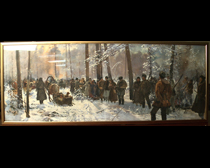SEPTEMBER 22, 2011
NEW YORK, NY
Paintings were stolen by the Nazis in 1944 – recovered following ICE HSI investigation
NEW YORK — Nearly seven decades after they were stolen by the Nazis, the Julian Falat paintings "The Hunt" and "Off to the Hunt" are back in the hands of their rightful owner, the people of Poland. At a ceremony today at the Polish Consulate in New York, U.S. Immigration Customs and Enforcement's (ICE) Homeland Security Investigations (HSI) and the U.S. Attorney's Office for the Southern District of New York, returned the paintings to Polish President Bronislaw Komorowski.
The oil on panel paintings returned today were stolen from the Polish National Museum in Warsaw, Poland, by the Nazis during World War II.
"We are deeply gratified to be able to return these cherished paintings that were taken from the people of Poland so long ago," said ICE HSI Executive Associate Director James Dinkins. "Through our investigations into illicitly trafficked cultural property, we take every opportunity to track down objects stolen during World War II."
"Those paintings are two magnificent and very important pieces of art," said Bogdan Zdrojewski, minister of culture and national heritage, Republic of Poland. "If you think about all the Falat paintings, these two are definitely the most interesting and most valuable ones."
"No one can ever provide just compensation to the victims of the Nazis' atrocities, but it is very gratifying for our office to play a role in returning the art that they looted during World War II to its rightful owners," said U.S. Attorney Preet Bharara, Southern District of New York. "After 60 years, these national treasures will finally be returned to the Polish Government – a repatriation that would not have been possible without their help."
According to a complaint filed on Dec. 15, 2010, in Manhattan federal court, in August 1944, the German S.S. Obersturmbannführer Benne Von Arent took over the Polish National Museum and confiscated the most valuable items in the museum's possession, including "The Hunt" and "Off to the Hunt." Many of those treasures are still missing and have not been returned to the rightful owners. In 2006, the Polish government enlisted the assistance of ICE HSI and INTERPOL when it was notified that these two national treasure paintings were being offered for sale at two New York auction houses.
After ICE HSI conducted an investigation into the paintings, the U.S. Attorney's Office for the Southern District of New York filed a civil complaint against the two paintings seeking their forfeitures on several bases, including that the paintings constitute stolen property imported into the United States in violation of law.
Falat was born in 1853 in Tuliglowy, Poland, and is well known for his hunting and landscape paintings. In November 1901, his "Off to the Hunt" painting was first publicly displayed at the Society for the Encouragement of Fine Arts in Warsaw. It was subsequently sold to a private individual who later returned the painting to the society as a gift in 1904. In December 1939, "Off to the Hunt" was transferred from the society to the premises of the Polish National Museum which was used by the Nazis during World War II as a German depository of Polish national treasures.
"Off to the Hunt" was last documented at the museum. Sometime during World War II, "Off to the Hunt" was removed from the museum by the Nazis without its frame. It had been missing until 2006 when the Polish government became aware that it was being offered for sale at an auction house in New York.
The Falat painting entitled "The Hunt" was bequeathed on June 6, 1914 by its first owner, Ludwik Norblin, to the society. During World War II, "The Hunt" was also moved to the Polish National Museum. "The Hunt" was stolen by the Nazis during World War II and remained missing until 2006 when the Polish government became aware that the painting was being offered for sale at a different auction house in New York.
ICE HSI plays a leading role in criminal investigations that involve the illicit importation and distribution of cultural property, as well as the illegal trafficking of artwork. The agency specializes in recovering works that have been reported lost or stolen. The ICE HSI Office of International Affairs, through its 70 attaché offices in 47 countries, works closely with foreign governments to conduct joint investigations, when possible.
ICE HSI specially trained investigators and foreign attachés partner with governments, agencies and experts to protect cultural antiquities. They also train investigators from other nations and agencies on how to find and authenticate cultural property, and how to best enforce the law to recover these items when they emerge in the marketplace.
Those involved in the illicit trafficking of cultural property, art and antiquities can face prison terms of up to 20 years, fines and possible restitution to purchasers of the items.
Since 2007, ICE HSI has repatriated more than 2,500 items to more than 22 countries including paintings from France, Germany and Austria; an 18th century manuscript from Italy; and a bookmark belonging to Hitler as well as cultural artifacts from Iraq including Babylonian, Sumerian and neo-Assyrian items.




